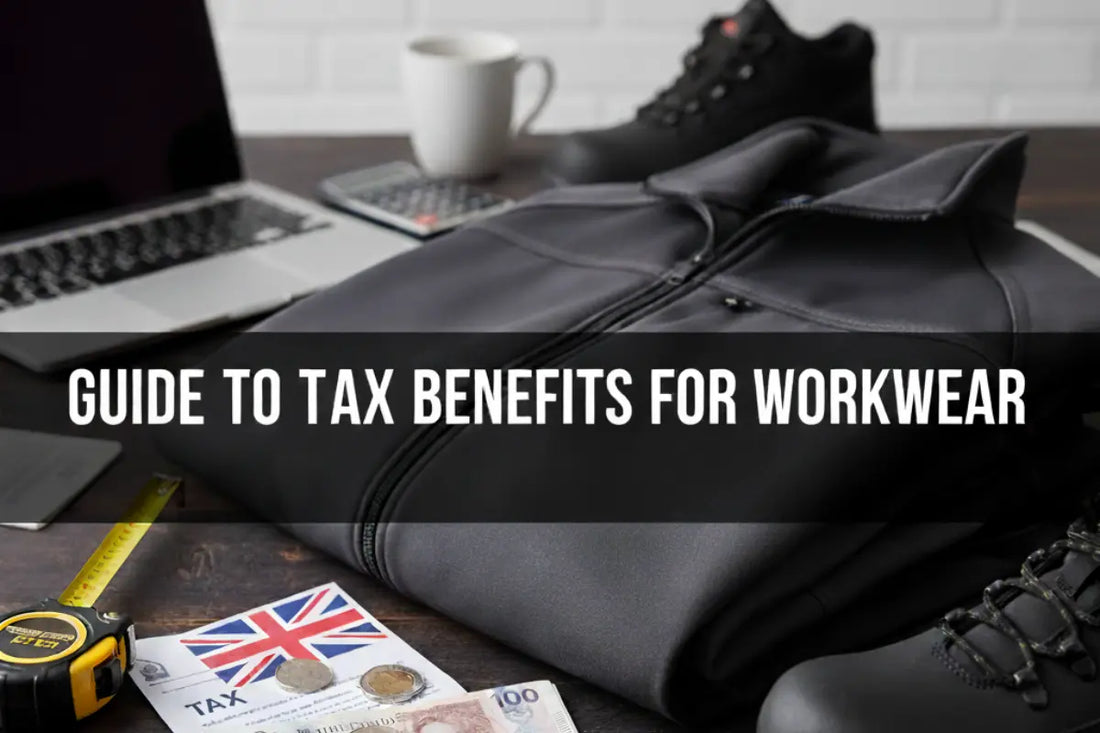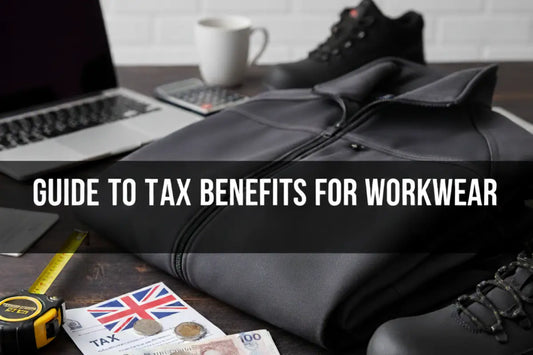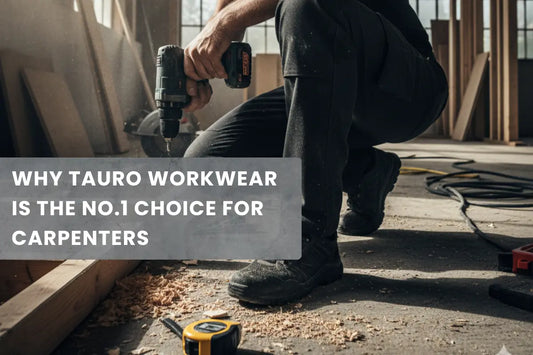
Understanding Tax Benefits for Workwear Expenses: A Tradesman's Guide to Claiming Back on Quality Kit
Let's talk about something that doesn't get nearly enough attention in site cabins and workshops across the UK: the tax relief you're entitled to claim on your workwear. We've noticed that loads of tradesmen are leaving money on the table simply because they don't realise what they can claim, or they think the paperwork isn't worth the hassle. Spoiler alert—it absolutely is.
If you're investing in proper workwear (the kind that actually holds up on site rather than falling apart after three months), understanding these tax benefits can significantly offset your costs. Particularly relevant if you've recently upgraded to premium kit that does the job properly.
The Basics: What Qualifies as Tax-Deductible Workwear?
Here's where it gets interesting. HMRC has specific criteria for what counts as allowable workwear expenses, and understanding these rules can make a real difference to your bottom line.
Your workwear qualifies for tax relief when it meets certain conditions. The clothing must be necessary for your work and not suitable for everyday wear. This is crucial—HMRC won't let you claim for a pair of jeans you could wear down the pub, even if you do wear them on site.
Qualifying workwear typically includes:
Protective clothing that's essential for your trade falls squarely into the deductible category. We're talking about gear that shields you from workplace hazards—items with reinforced knees for tilers and floorers, hi-vis elements for anyone working near traffic, or flame-resistant materials for welders and electricians.
Specialist clothing with features designed specifically for your trade also qualifies. Take slim fit mens workwear trousers with integrated knee pad pockets, tool loops, and reinforced stress points. These aren't regular trousers with a different label—they're purpose-built for the job. Understanding what qualifies as workwear in your industry helps ensure you're claiming everything you're entitled to.
Branded workwear with your company logo printed or embroidered on it is particularly straightforward to claim. HMRC recognises that once you've stuck your company name on it, you're unlikely to wear it anywhere else.
Self-Employed vs. PAYE: Different Rules Apply
The way you claim depends on your employment status, and the differences are significant.
For Self-Employed Tradesmen
If you're running your own show through a limited company or as a sole trader, you can claim workwear as a legitimate business expense. This gets deducted from your profits before you calculate your tax bill, which means you're reducing both your income tax and National Insurance contributions.
The key is keeping proper records. Save every receipt, note what you bought and when, and keep a log of why specific items were necessary for your work. Your accountant will thank you come year-end, and HMRC won't have grounds to question your claims.
You'll include these expenses on your Self Assessment tax return. The allowable amount goes in the 'Allowable business expenses' section, which directly reduces your taxable profit.
For PAYE Employees
Working for someone else doesn't mean you can't claim—it just works differently. You can claim tax relief on workwear expenses through HMRC's online portal, which will adjust your tax code to give you the relief over the following tax year.
The amount you get back depends on your tax rate. As a basic rate taxpayer (earning between £12,571 and £50,270), you'll get 20% back. Higher rate taxpayers at 40% get even more relief, though let's be honest—most tradesmen on the tools aren't in that bracket.
One catch: if your employer has already reimbursed you for workwear, you can't double-dip by claiming tax relief as well. That said, many employers don't reimburse the full cost of quality kit, and you can claim relief on the difference.
What You Can Actually Claim: Breaking Down the Categories
| Expense Category | Examples | Typical Deductibility |
|---|---|---|
| Protective Workwear | Steel toe cap boots, hard hats, safety glasses, hi-vis jackets | Fully deductible |
| Specialist Trousers | Holster pocket work trousers, reinforced knee trousers | Fully deductible |
| Cleaning & Maintenance | Specialist cleaning products, repairs, reproofing treatments | Fully deductible |
| Replacement Kit | Like-for-like replacements of worn-out gear | Fully deductible |
| Initial Uniform | First set of branded workwear | Deductible with records |
| Regular Clothing | Plain jeans, regular trainers, everyday t-shirts | Not deductible |
The cleaning and maintenance angle often gets overlooked. If you're washing your work trousers separately from your regular clothes (and you should be—site dirt and brick dust don't belong in the same load as your casual wear), you can claim a portion of your laundry costs. Proper care and maintenance of your workwear not only extends its lifespan but also provides additional tax-deductible expenses. Some tradesmen even claim for separate laundry equipment if it's exclusively for work gear.
The Premium Kit Advantage: Why Better Workwear Makes Financial Sense
Here's something we've seen time and again: tradesmen who invest in quality workwear actually spend less over time, even before tax relief comes into play.
Cheap workwear from big-box retailers might seem like a bargain at £25 a pair, but when those trousers last four months and the knees blow out, you're replacing them three times a year. That's £75 annually, plus the hassle of constantly buying new kit.
Compare that to investing in properly constructed trousers like our Rampage workwear trousers with holster pockets. Yes, the upfront cost is higher, but these are built to last significantly longer. Better stitching, reinforced stress points, and quality fabrics mean they're still going strong when budget alternatives have long since hit the bin. Understanding the key features to look for when choosing workwear trousers helps you make smarter purchasing decisions.
Factor in the tax relief—potentially 20-40% back depending on your circumstances—and the real cost drops considerably. Suddenly, premium workwear that actually performs looks like the sensible financial choice it always was. Our guide to best value workwear breaks down why quality represents better value in the long run.
Keeping Records That Stand Up to Scrutiny
HMRC can request evidence for any claims you make, typically going back four years. Losing receipts isn't just annoying—it could cost you money if you can't substantiate your claims during an inspection.
Digital record-keeping makes life easier. Snap photos of receipts with your phone immediately after purchase and store them in a dedicated folder. Cloud storage means you won't lose everything if your phone takes a swim in a cement mixer (it happens).
For online purchases, save the order confirmation emails and invoices. Most suppliers, including Tauro Workwear, send detailed invoices that clearly itemise what you've bought—perfect for your records.
Create a simple spreadsheet tracking your purchases. Include the date, supplier, item description, cost, and whether it's been claimed. Takes five minutes a month and saves hours of headaches at tax time.
Flat Rate Expenses: The Easy Alternative
HMRC offers flat rate expense allowances for certain industries, which can simplify matters considerably. Rather than tracking every individual purchase, you claim a standard annual amount based on your trade.
For example, carpenters can claim £120 per year, plumbers £120, and construction industry workers generally £60-£120 depending on specific roles. You don't need receipts for flat rate claims—just evidence that you work in the qualifying industry.
The catch? You can't claim both flat rate expenses and itemised workwear costs. You need to calculate which approach gives you the better relief.
Should you use flat rate expenses?
| Your Situation | Better Approach |
|---|---|
| Spending less than £100 annually on workwear | Claim flat rate (simpler, no receipts needed) |
| Spending £200-300 annually on quality workwear | Itemise actual expenses (better relief) |
| Poor record-keeping or lost receipts | Flat rate prevents losing out entirely |
| Running your own business | Always itemise for maximum deduction |
For most tradesmen investing in proper kit, itemising actual expenses delivers better tax relief than flat rate allowances. But flat rate beats claiming nothing at all, which is what too many people default to.
Making Your Claim: The Practical Steps
For self-employed tradesmen, the process integrates into your normal Self Assessment return. When completing your tax return (by 31st January for the previous tax year), you'll include your workwear expenses in the allowable business expenses section.
Your accountant handles this if you use one. If you're doing your own books, keep all your workwear receipts separate from other business expenses—it makes the process cleaner and gives you clear visibility of what you're spending on kit.
For PAYE employees, you claim through HMRC's online services. You'll need your Government Gateway login (the same one you use for Self Assessment if you've previously done one). Navigate to the 'Income Tax' section, then 'Tell us about a change,' then 'Other.'
Select the option for claiming work-related expenses and follow the prompts to enter your workwear costs. HMRC processes these claims relatively quickly—usually within a few weeks—and adjusts your tax code to give you the relief over the remainder of the tax year.
You can claim for previous tax years too, going back up to four years. If you've been spending on workwear but never claimed, you could have a decent refund coming your way.
Common Mistakes That Cost Money
We've seen plenty of tradesmen lose out on legitimate claims through simple errors. Here's what to avoid.
Assuming everyday clothes count. That pair of comfortable jeans you wear on site? Not claimable unless they have specific work features or your company logo. HMRC's test is whether you'd realistically wear the item outside work—if yes, it probably doesn't qualify.
Forgetting about the small stuff. Yes, you can claim those £15 knee pads you bought separately. The individual amounts might seem trivial, but they add up over a year.
Missing the cleaning costs. If you're taking your work trousers to a launderette or dry cleaners, those receipts count. Even home washing—a reasonable proportion of your washing powder, electricity, and water—can be claimed if you keep work laundry separate.
Not claiming because amounts seem too small. There's no minimum threshold for workwear claims. £50 of tax relief might not change your life, but it'll cover a tank of diesel or a few pints with the crew.
Throwing away receipts too soon. Keep them for at least six years to be safe. HMRC can investigate that far back in cases of suspected irregularities.
Why Quality Workwear Is an Investment, Not an Expense
There's a mindset shift that happens when you start viewing workwear through the lens of tax relief and long-term value rather than just upfront cost.
Take our Outlaw stretch workwear trousers. These aren't cheap, but they're not expensive either when you factor in durability and tax relief. The four-way stretch fabric moves with you, reducing fatigue during long days. The reinforced construction means they handle the abuse of real site work. And yes, they're tax deductible.
When you invest in kit that actually performs, you're not just getting better trousers—you're getting clothing that helps you work more efficiently, more comfortably, and with less hassle. That has value beyond the price tag. Understanding the strongest workwear fabrics helps you choose gear that truly lasts.
The tax relief simply acknowledges what should be obvious: workwear is a necessary business expense. HMRC provides these deductions because they recognise that tradesmen need specialist clothing to do their jobs safely and effectively.
Compliance and Safety Standards Matter for Claims
One aspect that often gets overlooked: workwear that meets proper safety standards is easier to justify as a tax-deductible expense. Understanding ISO, EN-ISO, and BS-EN-ISO standards ensures you're buying gear that's clearly work-specific rather than general clothing.
Choosing the right workwear brand that prioritises safety compliance and quality construction makes your claims more straightforward. HMRC is far less likely to question expenses for clearly professional-grade workwear from reputable suppliers.
The Bottom Line on Tax Relief
Here's the straightforward summary: if you're spending money on legitimate workwear, you should be claiming tax relief on it. Whether that's through itemised expenses or flat rate allowances, the relief is there for the taking.
For a tradesman spending £300 annually on quality workwear, we're talking about £60-120 back in tax relief depending on your rate. Over five years, that's potentially £600—enough to completely offset the cost of replacing your entire work wardrobe with premium kit.
The administrative burden is minimal once you establish a routine. Save receipts, track purchases, and claim annually. It becomes second nature after the first time.
We've built Tauro Workwear around the principle that tradesmen deserve better—better quality, better fit, better performance. Understanding the tax benefits of your workwear investments is part of that equation. You're already spending the money on kit you need. Make sure you're getting every penny back that you're entitled to.
The relief is yours by right. All you need to do is claim it.
Looking to upgrade your work trousers to kit that qualifies for tax relief and actually performs on site? Browse our range of slim fit mens workwear trousers designed specifically for modern tradesmen who demand better. Explore our complete workwear guide to make informed decisions about your professional clothing investment.




